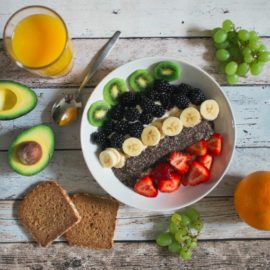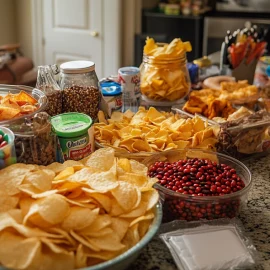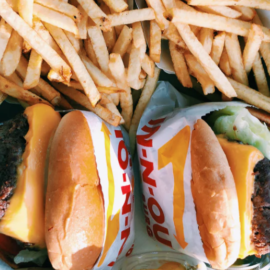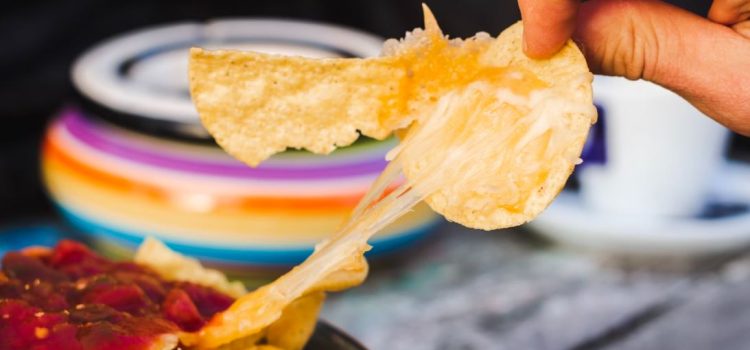
This is a free excerpt from one of Shortform’s Articles. We give you all the important information you need to know about current events and more.
Don't miss out on the whole story. Sign up for a free trial here .
When you get hungry, do you reach for processed snacks? Do you find yourself feeling stuffed after each meal?
There’s solid science behind why junk food addiction occurs—our bodies have evolved to seek out high-calorie food, and the food industry makes these foods addictive. But by getting back in touch with our natural hunger and fullness cues, we can resist the pull of junk food.
Here are four methods to break free of your junk food addiction, from proven experts.
End Your Addiction
Everyone knows we should avoid highly processed foods like chips, soda, and sweets. But junk food is designed to be addictive, and it can be hard to resist. To break the control that high-calorie, low-nutrient foods have over us, experts recommend reconnecting with our body’s natural hunger and fullness signals. Here’s how to break the junk food addiction.
1. Slow Down
In In Defense of Food, Michael Pollan writes that it takes 20 minutes for our stomachs to signal to our brains that we’re full. Unfortunately, many of us eat our meals at a much faster rate, meaning we continue to gorge on food before our bodies have time to react. Pollan recommends eating slowly, allowing your stomach to properly signal your brain when you’ve eaten enough.
2: Eat More Earlier in the Day
In How Not to Diet, Michael Greger writes that eating junk food leads to a catch-22 scenario where we crave ever more junk food: When your body digests healthful foods, it releases a steady stream of nutrients from that food into your bloodstream, creating hormonal changes that make you feel full. Because junk food lacks nutrients, this process of satiation isn’t triggered, and you end up feeling hungry again soon after you’ve eaten—and craving more junk food.
To break this damaging cycle, Greger recommends working with your body’s natural digestive clock. The amount of time and effort your body spends digesting food decreases during the day—in other words, you burn more calories digesting food in the morning than you do in the evening. Thus, if you eat your largest meal in the morning and your smallest in the evening, you’re aligning your eating with the rhythm of how your body wants to receive food.
(Shortform note: When it comes to nutrition, there’s a big difference between whole foods and the components that make up whole foods. Research consistently demonstrates that eating whole foods protects against cancers, heart disease, dementia, and early death. Many studies show that nutrients like vitamins and minerals are only beneficial when consumed in whole foods containing them. When these same nutrients are consumed independently of whole foods, they’re not effective. In other words, multivitamins and supplements generally don’t work for healthy people.)
3: Listen to Your Body’s Cues
In Intuitive Eating, Evelyn Tribole and Elyse Resch write that after spending years with a “clean your plate” mentality, you’ll likely have to work at getting back in touch with your body’s natural hunger and fullness cues. You may not even recognize comfortable fullness, having become accustomed to feeling “stuffed.”
To reacquaint yourself with these cues, Tribole and Resch recommend eating mindfully by assessing your hunger levels before, during, and after each meal. This means pausing in the middle of a meal to check in with your stomach and your taste buds—if you’re still feeling hungry and the food still tastes good, keep eating. If you’re starting to detect emerging fullness and the food isn’t as pleasurable anymore, stop.
(Shortform note: Whole foods like vegetables and meat have a high water content, but ultra-processed food (UPF) needs to be dry so it doesn’t go bad. Because it lacks moisture, UPF is very dense in calories. This calorie density, when combined with softness, means that UFC will cause you to consume more calories, faster, than you would with unprocessed foods. Studies consistently show that foods with high calorie density promote eating and weight gain.)
4. Practice Intermittent Fasting
In Fast. Feast. Repeat., Gin Stephens writes that to eat well, you must reacquaint yourself with your natural hunger cues, noting that as infants, we naturally sense the hormonal signals our body puts out indicating when we’re hungry and when we’re satisfied, but as we get older, we lose touch with these signals, leading us to overeat. She argues that the best way to reverse this process is by practicing intermittent fasting, in which you cycle between periods of fasting and periods of “feasting,” or eating.
Fasting is not dieting, Stephens writes. Dieting is limiting your overall calorie intake consistently and permanently, whereas fasting is incorporating periods of no-calorie intake into your day or week. Dieting doesn’t work because long-term calorie restriction, though it might be temporarily successful, leads to metabolic adaptation, where your body burns fewer calories and produces more hormones to increase your hunger because it thinks you’re starving. This is why, after dieting for a while, people often end up binging on junk food, undoing any results of dieting they’ve achieved. Fasting, in contrast, works with the way our bodies have adapted to periods of scarcity and abundance, and thus doesn’t trigger a starvation response.
The Western Diet Problem According to Michael Pollan in In Defense of Food, to change your habits away from the Western diet, you must differentiate the theories from the problem and work to address the latter. Regardless of the theory, the problem remains the same—eating a Western diet leads to Western diseases. The “how” and “why” are less important than the “what,” meaning you have to treat the whole problem, not just the symptoms. The following rules can help you cut ties with the Western diet. What to eat:
What not to eat:
How to eat:
Where to get food:
When you understand where food comes from and prepare it yourself, you become part of a healthier food chain. When the whole food chain is respected and supported, your health and the health of the natural world will be, as well. |
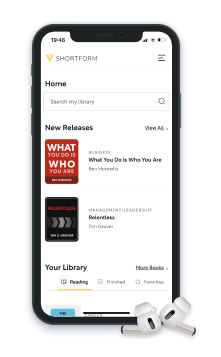
Want to fast-track your learning? With Shortform, you’ll gain insights you won't find anywhere else .
Here's what you’ll get when you sign up for Shortform :
- Complicated ideas explained in simple and concise ways
- Smart analysis that connects what you’re reading to other key concepts
- Writing with zero fluff because we know how important your time is


